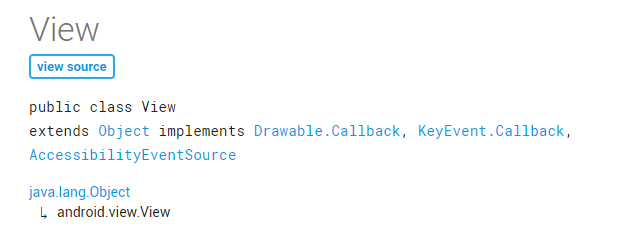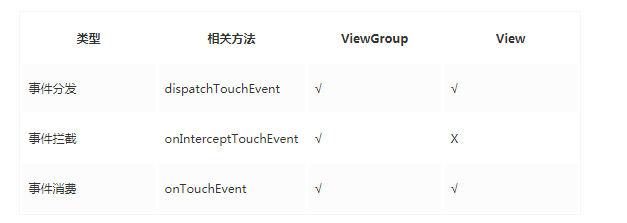总结
1.Android事件分发是先传递到ViewGroup,再由ViewGroup传递到View。
2.在ViewGroup中可以通过onInterceptTouchEvent方法对事件传递进行拦截,onInterceptTouchEvent方法返回true代表不允许事件继续向子View传递,返回false代表不进行截断。默认值为false
3.子View中如果将传递的事件消费,则ViewGroup中将无法接收事件。
解析
View的介绍,摘自Android developer


ViewGroup的介绍


自我理解如下:
1:ViewGroup继承了View类,可以包含子View,可以理解为一组View的集合。
2:View是ui组件的直接父类或者间接父类,例如常用的TextView,EditText等等。而ViewGroup是Android中所有布局的父类或者间接父类,例如常用的LinearLayout,RelativeLayout等等。
实例:
布局:自定义MyGroupLayout,继承LinearLayout,间接继承于ViewGroup
public class MyGroupLayout extends LinearLayout{ public MyGroupLayout(Context context) { super(context); } public MyGroupLayout(Context context, @Nullable AttributeSet attrs) { super(context, attrs); } public MyGroupLayout(Context context, @Nullable AttributeSet attrs, int defStyleAttr) { super(context, attrs, defStyleAttr); } public MyGroupLayout(Context context, AttributeSet attrs, int defStyleAttr, int defStyleRes) { super(context, attrs, defStyleAttr, defStyleRes); } }
<com.example.viewontouch.MyGroupLayout xmlns:android="http://schemas.android.com/apk/res/android" xmlns:app="http://schemas.android.com/apk/res-auto" xmlns:tools="http://schemas.android.com/tools" android:layout_width="match_parent" android:layout_height="match_parent" tools:context=".MainActivity" android:id="@+id/layout"> <Button android:id="@+id/button" android:layout_width="match_parent" android:layout_height="wrap_content" /> </com.example.viewontouch.MyGroupLayout>
MainActivity主类中实现
private void initView(){ layout = findViewById(R.id.layout); button = findViewById(R.id.button); layout.setOnTouchListener(new View.OnTouchListener() { @Override public boolean onTouch(View v, MotionEvent event) { Log.i("Tag","layout on touch"); return false; } }); button.setOnClickListener(new View.OnClickListener() { @Override public void onClick(View v) { Log.i("Tag","click the button"); } }); }
运行结果
点击button

点击空白区域

为啥运行结果如此?
主要是因为layout的事件分发机制导致的。
ViewGroup中有一个onInterceptTouchEvent方法,接下来我们看代码
public boolean onInterceptTouchEvent(MotionEvent ev) { if (ev.isFromSource(InputDevice.SOURCE_MOUSE) && ev.getAction() == MotionEvent.ACTION_DOWN && ev.isButtonPressed(MotionEvent.BUTTON_PRIMARY) && isOnScrollbarThumb(ev.getX(), ev.getY())) { return true; } return false; }
故事件分发传递至button的点击事件
如果我们在MyGroupLayout中复写此方法,再次点击,则无论点击何处,都是触发layout的touch事件。


原因:
Android中touch事件的传递,是先传递到ViewGroup,再传递到View的。
看ViewGroup中事件分发方法源码
@Override public boolean dispatchTouchEvent(MotionEvent ev) { if (mInputEventConsistencyVerifier != null) { mInputEventConsistencyVerifier.onTouchEvent(ev, 1); } // If the event targets the accessibility focused view and this is it, start // normal event dispatch. Maybe a descendant is what will handle the click. if (ev.isTargetAccessibilityFocus() && isAccessibilityFocusedViewOrHost()) { ev.setTargetAccessibilityFocus(false); } boolean handled = false; if (onFilterTouchEventForSecurity(ev)) { final int action = ev.getAction(); final int actionMasked = action & MotionEvent.ACTION_MASK; // Handle an initial down. if (actionMasked == MotionEvent.ACTION_DOWN) { // Throw away all previous state when starting a new touch gesture. // The framework may have dropped the up or cancel event for the previous gesture // due to an app switch, ANR, or some other state change. cancelAndClearTouchTargets(ev); resetTouchState(); } // Check for interception. final boolean intercepted; if (actionMasked == MotionEvent.ACTION_DOWN || mFirstTouchTarget != null) { final boolean disallowIntercept = (mGroupFlags & FLAG_DISALLOW_INTERCEPT) != 0; if (!disallowIntercept) { intercepted = onInterceptTouchEvent(ev); ev.setAction(action); // restore action in case it was changed } else { intercepted = false; } } else { // There are no touch targets and this action is not an initial down // so this view group continues to intercept touches. intercepted = true; } // If intercepted, start normal event dispatch. Also if there is already // a view that is handling the gesture, do normal event dispatch. if (intercepted || mFirstTouchTarget != null) { ev.setTargetAccessibilityFocus(false); } // Check for cancelation. final boolean canceled = resetCancelNextUpFlag(this) || actionMasked == MotionEvent.ACTION_CANCEL; // Update list of touch targets for pointer down, if needed. final boolean split = (mGroupFlags & FLAG_SPLIT_MOTION_EVENTS) != 0; TouchTarget newTouchTarget = null; boolean alreadyDispatchedToNewTouchTarget = false; if (!canceled && !intercepted) { // If the event is targeting accessiiblity focus we give it to the // view that has accessibility focus and if it does not handle it // we clear the flag and dispatch the event to all children as usual. // We are looking up the accessibility focused host to avoid keeping // state since these events are very rare. View childWithAccessibilityFocus = ev.isTargetAccessibilityFocus() ? findChildWithAccessibilityFocus() : null; if (actionMasked == MotionEvent.ACTION_DOWN || (split && actionMasked == MotionEvent.ACTION_POINTER_DOWN) || actionMasked == MotionEvent.ACTION_HOVER_MOVE) { final int actionIndex = ev.getActionIndex(); // always 0 for down final int idBitsToAssign = split ? 1 << ev.getPointerId(actionIndex) : TouchTarget.ALL_POINTER_IDS; // Clean up earlier touch targets for this pointer id in case they // have become out of sync. removePointersFromTouchTargets(idBitsToAssign); final int childrenCount = mChildrenCount; if (newTouchTarget == null && childrenCount != 0) { final float x = ev.getX(actionIndex); final float y = ev.getY(actionIndex); // Find a child that can receive the event. // Scan children from front to back. final ArrayList<View> preorderedList = buildTouchDispatchChildList(); final boolean customOrder = preorderedList == null && isChildrenDrawingOrderEnabled(); final View[] children = mChildren; for (int i = childrenCount - 1; i >= 0; i--) { final int childIndex = getAndVerifyPreorderedIndex( childrenCount, i, customOrder); final View child = getAndVerifyPreorderedView( preorderedList, children, childIndex); // If there is a view that has accessibility focus we want it // to get the event first and if not handled we will perform a // normal dispatch. We may do a double iteration but this is // safer given the timeframe. if (childWithAccessibilityFocus != null) { if (childWithAccessibilityFocus != child) { continue; } childWithAccessibilityFocus = null; i = childrenCount - 1; } if (!canViewReceivePointerEvents(child) || !isTransformedTouchPointInView(x, y, child, null)) { ev.setTargetAccessibilityFocus(false); continue; } newTouchTarget = getTouchTarget(child); if (newTouchTarget != null) { // Child is already receiving touch within its bounds. // Give it the new pointer in addition to the ones it is handling. newTouchTarget.pointerIdBits |= idBitsToAssign; break; } resetCancelNextUpFlag(child); if (dispatchTransformedTouchEvent(ev, false, child, idBitsToAssign)) { // Child wants to receive touch within its bounds. mLastTouchDownTime = ev.getDownTime(); if (preorderedList != null) { // childIndex points into presorted list, find original index for (int j = 0; j < childrenCount; j++) { if (children[childIndex] == mChildren[j]) { mLastTouchDownIndex = j; break; } } } else { mLastTouchDownIndex = childIndex; } mLastTouchDownX = ev.getX(); mLastTouchDownY = ev.getY(); newTouchTarget = addTouchTarget(child, idBitsToAssign); alreadyDispatchedToNewTouchTarget = true; break; } // The accessibility focus didn't handle the event, so clear // the flag and do a normal dispatch to all children. ev.setTargetAccessibilityFocus(false); } if (preorderedList != null) preorderedList.clear(); } if (newTouchTarget == null && mFirstTouchTarget != null) { // Did not find a child to receive the event. // Assign the pointer to the least recently added target. newTouchTarget = mFirstTouchTarget; while (newTouchTarget.next != null) { newTouchTarget = newTouchTarget.next; } newTouchTarget.pointerIdBits |= idBitsToAssign; } } } // Dispatch to touch targets. if (mFirstTouchTarget == null) { // No touch targets so treat this as an ordinary view. handled = dispatchTransformedTouchEvent(ev, canceled, null, TouchTarget.ALL_POINTER_IDS); } else { // Dispatch to touch targets, excluding the new touch target if we already // dispatched to it. Cancel touch targets if necessary. TouchTarget predecessor = null; TouchTarget target = mFirstTouchTarget; while (target != null) { final TouchTarget next = target.next; if (alreadyDispatchedToNewTouchTarget && target == newTouchTarget) { handled = true; } else { final boolean cancelChild = resetCancelNextUpFlag(target.child) || intercepted; if (dispatchTransformedTouchEvent(ev, cancelChild, target.child, target.pointerIdBits)) { handled = true; } if (cancelChild) { if (predecessor == null) { mFirstTouchTarget = next; } else { predecessor.next = next; } target.recycle(); target = next; continue; } } predecessor = target; target = next; } } // Update list of touch targets for pointer up or cancel, if needed. if (canceled || actionMasked == MotionEvent.ACTION_UP || actionMasked == MotionEvent.ACTION_HOVER_MOVE) { resetTouchState(); } else if (split && actionMasked == MotionEvent.ACTION_POINTER_UP) { final int actionIndex = ev.getActionIndex(); final int idBitsToRemove = 1 << ev.getPointerId(actionIndex); removePointersFromTouchTargets(idBitsToRemove); } } if (!handled && mInputEventConsistencyVerifier != null) { mInputEventConsistencyVerifier.onUnhandledEvent(ev, 1); } return handled; }
首先判断事件目标对象是否是可点击的,然后判断是否需要往下分发传递事件。
相关方法对比

后记:
其实感觉Android的事件分发机制跟现实中的工作环境有异曲同工之妙。一个任务,领导会先分发到小组长,小组长会判断你是否在场和是否有能力完成,如果你申请,这件事大概率会分发给你处理,如果不曾申请,则会看其他同事是否有申请,其次考虑分发。如果小组长截断,觉得这件事他处理比较好,则不会分发到组内成员手中。